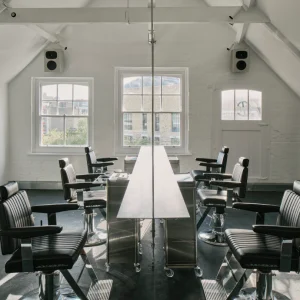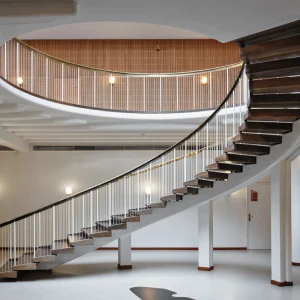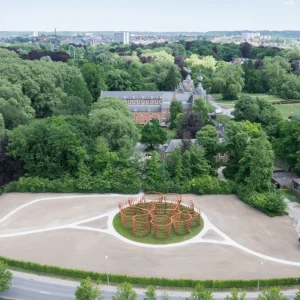
Laurence Quinn,
Quinn Architects
Where do you get your surface materials information?
From our own research or other projects we have seen, or from companies we’ve been to see that we believe are the best. We don’t generally go to trade fairs.
What new materials excite you?
Something that’s a mix between tradition and technology. We’re interested in the idea of craft, and are excited about handmade bricks and using them in a way that communicates that they are hand ade.
What materials do you return to?
We tend to go back to materials we’ve used and love such as polished concrete, zinc, copper, handmade bricks – materials we think will get better with age and contribute positively to the design. For a flat refurbishment in the Barbican, we made the most of every nook and cranny and used a lot of quarter-cut constructed oak veneer panelling. For the offices of Frieze art fair we used simple, cost-effective materials such as laminated ply – the sort of thing you might find at its fairs.
How often do you collaborate with manufacturers/specialists on bespoke surfaces, and which has been particularly successful?
We frequently work closely with manufacturers – we want to understand the products before we use them. We use CPD programmes to investigate and research materials and how they can be used. For a house we’re designing in Los Angeles, we’ve been working with Domus on very thin large-format porcelain tiles for walls and floors that we feel would be suitable.
What consideration do you give to sustainability?
Sustainability is about well-designed products that further down the line will still be fit for purpose. Locally sourced materials are very interesting to us.
Alex Mowat,
Urban Salon
Where do you get your materials information?
Everywhere! Mainly from bicycling around and from magazines – adverts and articles. When we do find something new the web is definitely the place to go to find out more. If companies have a poor website without accessible technical information on the product, we drop it.
What new materials excite you?
At the moment we’re very excited about bamboo because we can use it as the same surface for furniture, floors and walls. It has the density of oak, is very durable and because it’s coppiced, is sustainable.
We also use lino a lot for floors rather than vinyl and we like a new Forbo range Touch Solo, which has a textural grain to it and is really nice to touch. This makes the lino feel non-schooly. There aren’t many colours available yet, however.
We’ve also just started working with Bute Fabrics on a brewery project in Stockport. Bute is really ethical and also super efficient. There can’t be many furnishings companies where everything is done in the UK – from its own sheep for wool to make the material through to the marketing.
What materials do you return to?
Bamboo – we find ways of using it in every project. It’s become an ongoing research project and we’re thinking of taking students to China to where it’s made as a research trip.
How often do you collaborate with manufacturers/specialists on bespoke surfaces, and which has been particularly successful?
Our ongoing collaboration with the MWC group on bamboo. We also worked well with Ibstock on our Bermondsey Square building. It produced specials of its Tilebrick for us to use to give a continuous surface around the corners.
What’s your approach to sustainability?
Do it once and do it well rather than lots of throwaways.
Working with the clients at the Robinson Brewery in Stockport has made us think about sustainability – it is a family firm and genuinely thinks about whether the new bar we’re doing will look good for their great-great grandchildren. We’ve been thinking harder about patinas that gain a lustre in age rather than using new materials that scratch and wear, and are using oak and copper for the bar. The idea is that it will gain a patina and will wear in rather than wear out – the more wear it gets the better.





